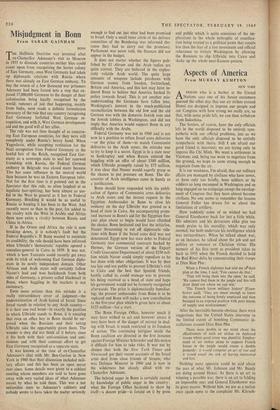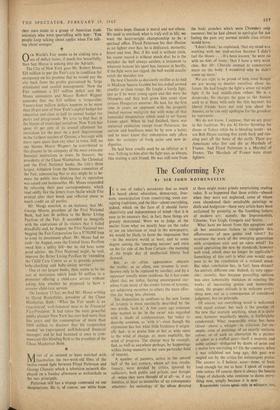in the failure to secure a full bourgeois revolu- tion
in the seventeenth century, which has led to our economic growth having to struggle with a social structure that has often been inimical to it. And, of course, this social structure has also deeply influenced the development of the working class and of its politics. Dr. Hobsbawm has some very wise things to say about the in- fluence of a great empire on the development of a 'labour aristocracy,' but misses the irony of his label in the context of nineteenth-century British society.
However, this interlocking of a pre-industrial social and political structure with an indus- trialised economy in the context of a world empire has, at least, made the history of Britain from 1800 one of the most complex and fas- cinating subjects available for historical study. Dr. Hobsbawm and Professor Checkland pro- vide admirable guides to its difficulties and com- plexities; but a great work of synthesis is still needed, and before that can be done there is im- perative need for a large corpus of co-operative
studies. Will no foundation give us an institute for the study of industrial society? Half a million would set it going. Should we not try to under- stand ourselves and our world? The materials are abundant and waiting to be used.
Robert Bruce
G. W. S. BARROW
PHILIP MAGNUS, EVENING STANDARD:
'Lucidity is the outstanding attribute of this distinguished study. . . . The narrative is enthralling; it is admirably documented . . . deserves to be congratulated warmly upon this splendid three-dimensional por- trait of a great man wrestling with great problems in a troubled and distant age.'
THE TIMES LITERARY SUPPLEMENT:
`Scholarly study, which with a wealth al documentation re-examines the theme in the light of recent research. . . . Robert Bruce here stands authentically in the fore- front of his own Scotland.'
COLM BROGAN, SPECTATOR:
'Profoundly interesting and scholarly book,
THE TIMES:
'In his careful, well documented, unspecu- lative style Professor Barrow builds up a picture of Bruce's age that is wholly con- vincing.' Frontispiece. 13 maps, 50s.
journey out of Anger
JOHN A. WILLIAMS
A new novel by the author of Night Song. A negro brother and sister return to the dying mother whose ambition has driven them to success. 18s EYRE & SPOTTISWOODE
efficiency is that throughout all this expansion It has managed to maintain its profit ratio on the net capital employed at around 25 per cent. Of the seven directors, six are full-time executives, each responsible for a separate division. Their efficiency has been demonstrated by the trading results. In the past six years the dividend has been steadily increased and has never been covered less than 1.8 times. The half-yearly figures, published in October, showed that sales Were running ahead of the industry's average. The interim dividend was raised from 7} per Cent to 8 per cent, indicating 25 per cent for the year. At 30s. 3d.-which is 20 per cent down from its 1964 high-the shares yield close on 4 Per cent. Although expansion may be slowing down, the shares are still a 'growth' long-term Investment.
TIn, results from British American Tobacco disappointed the market a little, in spite of the fact that pre-tax profits were up from £74.27
million to £76.03 million, but with tax rate up from 51.3 per cent to 53 per cent, earnings are
Marginally lower.. The dividend, however, is up from 20.5 per cent to 21.67 per cent, both tax- !rec. In future, with the company facing a higher income tax rate and corporation profits tax, dividends will be paid gross. The first interim dividend this year is Is. Id. gross, which is the equivalent of 7.96d. net. Since the announcement of the dividends, there has been a certain amount ()f switching from BATS into IMPS. The pricepf the 10s. shares has fallen to 49s. 3d. xd. to yield 7.2 Per cent. .. Lower profits were anticipated by Monotype for 1964 and this has turned out to be the case, wIth pre-tax profits down from £973,000 to '193,000, but the dividend is maintained at 7 per cent. The company exports 70 per cent of 115 turnover from its factories at Salfords (ip4urreY), Crawley (Sussex) and Dunfermline 'Ife). In anticipation of new benefits for ex- horters, this should stimulate future profits. The chairman may throw /some light on this subject 4,_t the forthcoming annual general meeting on March 9. The £1 shares at 26s. yield 5.4 per cent. , P. W. Woolworth has probably been hard hit ?Y rising costs, plus the fact that price-cutting In certain sectors was made. The trading sur- Plus was £40.248 million against £39.589 million, 4 disappointing improvement when multiple re- ti.Illers last year were (according to the Board of rade) showing monthly increases of around 10 her cent. Net profits of £16.770 million against 4j263 million have been arrived at after pro- ng for income tax at 8s. 3d. in the £. Wool- worth has plans to spend £37 million on store development. The chairman states that his or- ganisation will meet the problems of 1965 with Q, htlmism. Perhaps he will enlarge on this point 4,t the annual general meeting on March 5. The ''s• shares at 21s. 3d. yield 4.7 per cent. , Lindustries, the textile and engineering group, Ia% done well for the year ended September 30, ll 9.64. Pre-tax profits have jumped from £1.023 n. illtion to £1.573 million and the net profit is op by 38 per cent to £708,000. The interim divi- dend was raised by 1 per cent to 5 per cent lent the final is up by 3 per cent, making 11 per ll'ent (i.e., 16 percent for the year). Pre-tax profits rpm the engineering section were up by £349,000, v',1th £166,000 more from textiles and £35,000 More from the overseas section. If this trend con-
Company Notes
By LOTHBURY Stone-Platt Recovery Since Platt, the biggest textile machinery makers in the country, merged with Stone and Company, the largest manufacturers of air- conditioning and refrigeration equipment for rail- ways and road transport, the profits have been disappointing. Nor did the acquisition of the ships' propeller business of Manganese Bronze bring much stimulus. But huge orders for textile machinery worth £27 million were received last year from India and Russia and the chairman has stated that profits in 1965 will be higher than for any year since the merger. As 55 per cent of the UK output is exported, the company should benefit from the tax rebates for exporters. At 10s. 9d., against a high of 12s., the shares yield 71 per cent on dividends and 10 per cent on earnings.
tinues, the £1 shares (with the dividend more than twice covered) at 45s. xd. look attractive, yielding 7.1 per cent.
Chess
By PHILIDOR
218. G. RICHARDSON ;Observer, May 1925, BLACK '4 men) Wril FL '1/49 men) WHITE to play and mate in two moves ; solution next week. Solution to No. 217 (Heydon): Kt-K 4, no threat. Admirable early example of a mutate where five of the mates in the set position (i.e. mates that would occur if Black, not White, moved first) arc changed and that there is one added mate, e.g. r ... B-Kt 2; z Q x B (set Q x Kt) or I . . . P-Q Kt .6 ; 2 Kt-B 3 (set P-B 4). I leave readers to work the rest out for themselves.



































 Previous page
Previous page